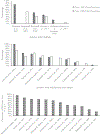A systematic review of risk for the development and persistence of self-injurious behavior in intellectual and developmental disabilities
- PMID: 35580423
- PMCID: PMC10229071
- DOI: 10.1016/j.cpr.2022.102158
A systematic review of risk for the development and persistence of self-injurious behavior in intellectual and developmental disabilities
Abstract
Self-injurious behavior (SIB) by individuals with intellectual and developmental disabilities including autism (I/DD) is among the most clinically disturbing, socially costly, and scientifically challenging behavior disorders. Forty years of clinical research has produced a knowledge base supporting idiographic behavioral assessment and treatment approaches. Despite the treatment progress, from a public health and population perspective, we argue it is less clear that we have reduced the disorder's burden. The developmental course of the disorder is mostly unknown and empirically informed population-level models of risk are absent. In this review, we systematically examined the published scientific literature specific to risk for SIB in the I/DD population. We reviewed study methodology in detail intentionally informed by an epidemiological perspective with a set of questions intended to test the quality of the inferences about risk. Results are discussed in terms of conceptual, methodological, and translational issues with respect to what needs to be done to create credible and useful clinical models for SIB risk in the I/DD population.
Keywords: Intellectual/developmental disabilities; Longitudinal studies; Prospective cohort; Self-injurious behavior.
Copyright © 2022 Elsevier Ltd. All rights reserved.
Conflict of interest statement
Declaration of Competing Interest
None.
Figures


Similar articles
-
Parent training interventions for parents with intellectual disability.Cochrane Database Syst Rev. 2018 Jul 13;7(7):CD007987. doi: 10.1002/14651858.CD007987.pub3. Cochrane Database Syst Rev. 2018. PMID: 30004571 Free PMC article.
-
A systematic review of speech, language and communication interventions for children with Down syndrome from 0 to 6 years.Int J Lang Commun Disord. 2022 Mar;57(2):441-463. doi: 10.1111/1460-6984.12699. Epub 2022 Feb 22. Int J Lang Commun Disord. 2022. PMID: 35191587
-
Interventions for promoting habitual exercise in people living with and beyond cancer.Cochrane Database Syst Rev. 2018 Sep 19;9(9):CD010192. doi: 10.1002/14651858.CD010192.pub3. Cochrane Database Syst Rev. 2018. PMID: 30229557 Free PMC article.
-
Surveillance of Barrett's oesophagus: exploring the uncertainty through systematic review, expert workshop and economic modelling.Health Technol Assess. 2006 Mar;10(8):1-142, iii-iv. doi: 10.3310/hta10080. Health Technol Assess. 2006. PMID: 16545207
-
Exercise interventions and patient beliefs for people with hip, knee or hip and knee osteoarthritis: a mixed methods review.Cochrane Database Syst Rev. 2018 Apr 17;4(4):CD010842. doi: 10.1002/14651858.CD010842.pub2. Cochrane Database Syst Rev. 2018. PMID: 29664187 Free PMC article.
Cited by
-
Physical Aggression Toward Others and Self: Correlates in Autism, Attention-Deficit/Hyperactivity Disorder, and Population-Based Child Samples.JAACAP Open. 2023 Aug 1;1(4):274-283. doi: 10.1016/j.jaacop.2023.07.004. eCollection 2023 Dec. JAACAP Open. 2023. PMID: 39553453 Free PMC article.
-
A Qualitative Analysis of Family Caregiver Experiences Accessing Treatment for Self-Injurious Behavior in Individuals with Intellectual and Developmental Disabilities.J Ment Health Res Intellect Disabil. 2024;17(4):346-368. doi: 10.1080/19315864.2023.2223546. Epub 2023 Jun 11. J Ment Health Res Intellect Disabil. 2024. PMID: 39749252 Free PMC article.
-
Deep developmental phenotyping in children with tuberous sclerosis complex, with and without autism.Dev Med Child Neurol. 2025 Sep;67(9):1165-1175. doi: 10.1111/dmcn.16293. Epub 2025 Mar 7. Dev Med Child Neurol. 2025. PMID: 40051284 Free PMC article.
-
Botulinum Neurotoxin Injections in Children with Self-Injurious Behaviors.Toxins (Basel). 2023 Mar 23;15(4):236. doi: 10.3390/toxins15040236. Toxins (Basel). 2023. PMID: 37104174 Free PMC article.
-
Interdisciplinarity and self-injury: Toward an inclusive research and treatment paradigm.J Intellect Dev Disabil. 2024 Dec;49(4):378-390. doi: 10.3109/13668250.2024.2370564. Epub 2024 Jul 2. J Intellect Dev Disabil. 2024. PMID: 39815944
References
-
- Anderson LT, & Ernst M (1994). Self-injury in Lesch-Nyhan disease. Journal of Autism and Developmental Disorders, 24(1), 67–81. - PubMed
-
- Arron K, Oliver C, Moss J, Berg K, & Burbidge C (2011). The prevalence and phenomenology of self-injurious and aggressive behaviour in genetic syndromes. Journal of Intellectual Disability Research, 55(2), 109–120. - PubMed
-
- Aschengrau A, & Seage GR (2014). Essentials of epidemiology in public health. Burlington, MA: Jones & Bartlett Publishers.
-
- Baghdadli A, Pascal C, Grisi S, & Aussilloux C (2003). Risk factors for self-injurious behaviours among 222 young children with autistic disorders. Journal of Intellectual Disability Research, 47, 622–627. - PubMed
-
- Baghdadli A, Picot MC, Pry R, Michelon C, Burzstejn C, Lazartigues A, & Aussilloux C (2008). What factors are related to a negative outcome of self-injurious behavior during childhood in pervasive developmental disorders? Journal of Applied Research in Intellectual Disabilities, 21, 142–149.
Further readings
-
- Murphy GH, Beadle-Brown J, Wing L, Gould J, Shah A, & Holmes N (2005). Chronicity of challenging behaviours in people with severe intellectual disabilities and/or autism: A total population sample. Journal of Autism and Developmental Disorders, 35(4), 405–418. - PubMed
-
- Richman DM, Barnard-Brak L, Bosch S, Thompson S, Grubb L, & Abby L (2012). Predictors of self-injurious behaviour exhibited by individuals with autism spectrum disorder. Journal of Intellectual Disability Research, 1–11. - PubMed
-
- Rojahn JL (1984). Self-injurious behavior in institutionalized, severely/profoundly retarded adults: Prevalence data and staff agreement. Journal of Behavioral Assessment, 6, 13–27.
Publication types
MeSH terms
Grants and funding
LinkOut - more resources
Full Text Sources
Medical

